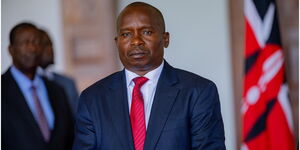President William Ruto has recently enjoyed a period of international acclaim, basking in the warmth of both Eastern and Western powers, and striding through global stages unchallenged.
At home, his reign seemed secure after quelling the Azimio protests of 2023. Yet, this façade of invincibility is now being threatened by the youth-driven protests against the controversial Finance Bill 2024. Aptly dubbed #RejectFinanceBill2024
While camped behind the sacred gates of State House, Ruto finds himself trapped in a fresh storm. The walls have begun closing in and the three years left on his first term must feel like an eternity of conflict.
The very demographic that propelled him to power, the youthful online community, has turned against him. A generation whose loyalty has never been to any party anyway, Gen Z, armed with their voices on platforms like X, TikTok, and Facebook, have now taken their grievances to the streets.
During his recent travels to the White House and the G7 summit, Ruto might have felt untouchable, enjoying the camaraderie of world leaders and an ostensibly secure position back home. While standing on platforms mortals would dream of, Ruto addressed the global audience about the Russia-Ukraine conflict with the confidence of a stable country.
However, the simmering discontent was brewing, and his political honeymoon had come to an abrupt end.
Just this past week, the largest protests since the fight for multiparty democracy erupted. Young Kenyans across 17 regions took to the streets, expressing their frustration with Ruto's administration. The scale and intensity of these protests have left Ruto backed into a corner, questioning when the rain fell hard on his seemingly well-run parade.
A new, bold generation of young Kenyan protesters has emerged, forcing the government to retreat on several unpopular tax proposals. The anger that started on TikTok over the Finance Bill, has snowballed into a full-fledged revolt. The protests, spanning Nairobi, Kisumu, Mombasa, and other major cities, have united Kenyans across ethnic and party lines.
If that were scary, then the fact that they were unsponsored by any political party, must present itself like a Hollywood horror flick.
Hundreds of trainer-wearing protesters, armed with smartphones, braved tear gas in Nairobi's central business district, live-streaming confrontations with police. Dubbed "Occupy Parliament," these protests were coordinated on social media, a stark contrast to traditional, politician-led demonstrations.
Experts agree that these protests have shifted the dynamics of Kenyan politics. Veteran journalist Mutuma Mathiu observed, "Protest politics found a new fulcrum and a new and different generation of Kenyans found their rather loud voice."
Political commentator Pauline Njoroge echoed this sentiment, noting the bravery and eloquence of the youth. Prof. Kivutha Kibwana, a law scholar and former county governor, urged dialogue, warning that declaring war on the youth is perilous. Dr. Willy Mutunga, a former chief justice, cautioned that young people globally share a common enemy in their ruling classes, hinting at an impending uprising.
Yet all the commentary seems to fall far from the mark; we simply do not know what to expect anymore. From leaked phone numbers to online 'flogging', to coordinated response centers. A new wave of protest has fallen on the shores of our country.
Facing an opposition without a clear leader and a nationwide movement against him, Ruto needs to innovate his political strategy like no president before him. Flashy gear, relatable dialogue, and catchy phrases will not suffice this time; he must take the battle online.
In response, President Ruto is reportedly recalibrating his strategy. According to sources, he convened a crisis meeting on Friday, June 21, to devise a plan to counteract the growing dissent.
The strategy? To deploy influencers to reshape his image and reclaim the narrative online. This harkens back to Ruto's 2022 campaign, where his digital strategy, spearheaded by social media maestros like Dennis Itumbi, was pivotal. However, this time, like the last call on a poker table, the stakes are higher and the terrain is more treacherous.
According to State House sources, Ruto’s government is set to begin deploying social media influencers to flood platforms with positive messages, attempting to stem the tide of criticism.
Despite achieving parliamentary victories, Ruto seems acutely aware that losing the public's support could be his undoing. The youth's mobilisation, unbound by traditional political affiliations, poses a unique threat. Their unity transcends ethnic and party lines, a feat long elusive in Kenyan politics.
The protests’ immediate success was marked by the government’s backtrack on several contentious tax proposals, including levies on bread and car ownership, and increases in mobile money transfer fees. These concessions, while significant, may only be the beginning of a broader struggle.
The Finance Bill’s climb-down, detailed in a parliamentary report, reflects the administration's recognition of the movement’s power. Yet, the underlying grievances—economic hardship, perceived governmental ineptitude, and a yearning for genuine representation—remain unaddressed.
It is anybody's guess where we go from here. How much energy does Gen Z have left in their bones and muscles? The riots are draining and the systems of power are forever intimidating. The race to 2027, the year on the top of everyone's lips, is not a sprint, but a marathon and the marathoners have only just left the starting blocks.
The youth's discontent, if left unresolved, could result in more profound and lasting political upheaval.
[OPINION PIECE]












